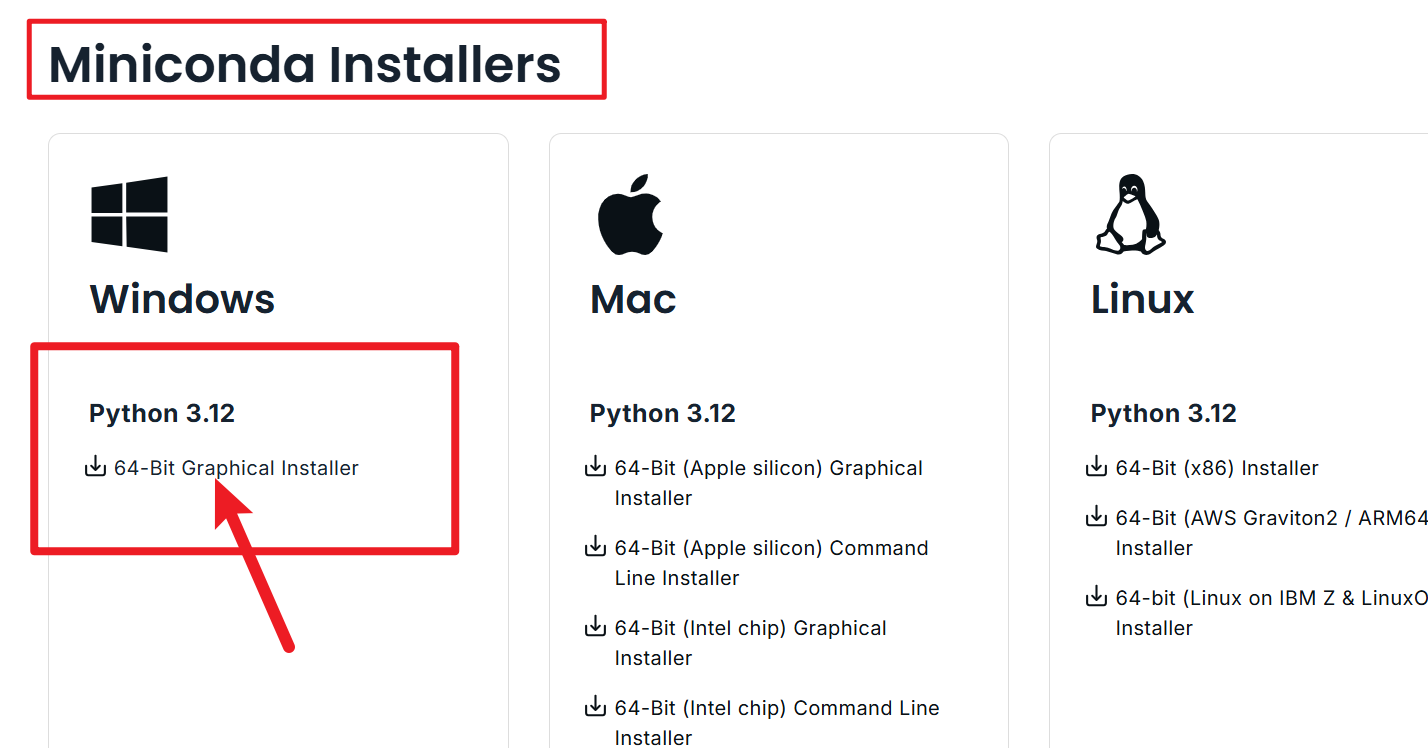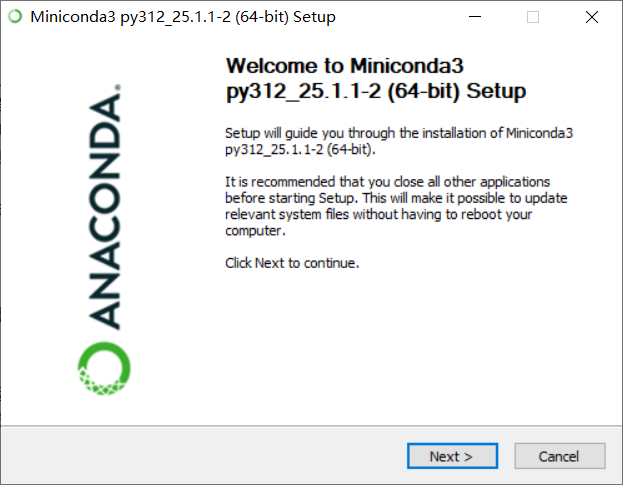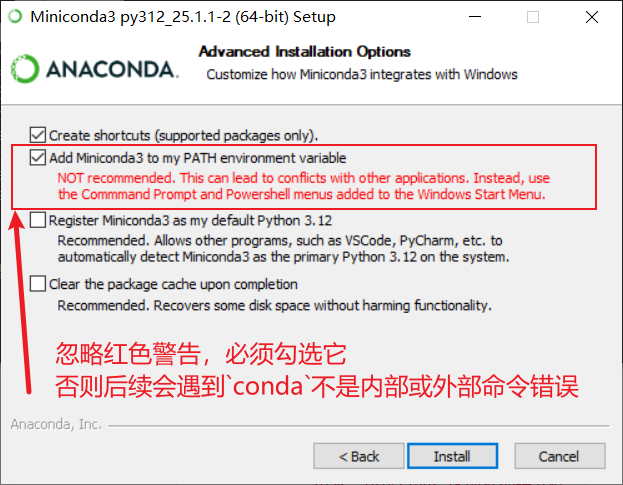Miniconda is a lightweight version of Anaconda that helps you quickly install Python and various packages. It's more suitable than the full Anaconda for beginners running AI programs.
This tutorial will guide you step-by-step through installing Miniconda on Windows 10 using the official download link, setting up a Python 3.10 environment, and installing common modules. Don't worry—even if you're a complete beginner, you can easily follow along!
Step 1: Download and Install Miniconda
Download Miniconda
Open your browser, enter this URL, and press Enter:
https://www.anaconda.com/download/success#minicondaScroll down to the "Miniconda" section, click the Windows download link, or use this direct link:
https://repo.anaconda.com/miniconda/Miniconda3-latest-Windows-x86_64.exe
The file will be saved to your "Downloads" folder (e.g.,
C:\Users\YourUsername\Downloads), with a filename likeMiniconda3-latest-Windows-x86_64.exe.
Install Miniconda
Double-click the downloaded file to open the installation window.
Click "Next," then agree to the license terms by clicking "I Agree."

Important: On the "Advanced Options" page, check Add Miniconda3 to my PATH environment variable to enable using the
condacommand directly. Otherwise, you may encounter the error:conda is not recognized as an internal or external command, operable program, or batch file.
Note: Some computers may warn against adding to PATH, but ignore it and check the box anyway. This is a common pitfall for beginners—without it, commands won't work.

- Click "Install," wait a few minutes, then click "Finish" when done.
Step 2: Verify Installation and Create a Python 3.10 Virtual Environment
Open the Command Line Terminal (CMD)
- Hold the Windows key + R to open the "Run" window.
- Type
cmdand press Enter to open the black command-line window.
Check if Miniconda is Installed Correctly
- In the command line, type:
conda --version
Press Enter. If you see something likeconda 25.1.1, the installation was successful.
- In the command line, type:

If it says "not recognized as an internal or external command," the environment variable wasn't added. Reinstall and check Add Miniconda3 to my PATH environment variable.  3. Create a Python 3.10 Virtual Environment
3. Create a Python 3.10 Virtual Environment
- In the command line, type:
conda create -n myai python=3.10 myaiis the environment name—you can choose any name (e.g.,ai_env).
- After pressing Enter, the system will download Python 3.10 and some base packages. It will ask "Y/N"—type
yand press Enter to continue.

- Activate the Virtual Environment
- Type:
conda activate myai
Press Enter. If you see(myai)at the beginning of the command line, you've successfully entered the environment.
- Type:

- Common Virtual Environment Commands
- Exit the environment: Type
conda deactivateand press Enter—the(myai)will disappear. - View all environments: Type
conda env listto see a list of your environments. - Delete an environment (if not needed): Type
conda env remove -n myaito remove it.
- Exit the environment: Type
Step 3: Install Modules and requirements.txt Using pip
Ensure You're in the Virtual Environment
- Type
conda activate myaiand confirm(myai)is visible.
- Type
Try Installing a Common Module
- For example, install
numpy(a math tool used by many AI programs):pip install numpy
Press Enter. After download and installation, check the version withpython -c "import numpy; print(numpy.__version__)".
- For example, install
Install requirements.txt
- If your AI software provides a
requirements.txtfile (listing required packages), copy it to a folder (e.g., a new "AIProject" folder on your desktop). - Navigate to the folder, delete the address bar content, type
cmd, and press Enter to open a terminal window:
- If your AI software provides a

- Then type:
pip install -r requirements.txt
Press Enter—it will automatically install all packages listed in the file.
Step 4: Common pip Commands and Error Handling
Common pip Commands
- Check pip version:
pip --versionto see if it's up to date. - Update pip: If the version is old, type
pip install --upgrade pip. - List installed packages:
pip listto see what's installed. - Uninstall a package: For example,
pip uninstall numpyto remove it.
- Check pip version:
Common Errors and Solutions
- Network errors (slow or failed downloads):
It might be a network issue—try again, or use a domestic mirror for speed:
pip install -r requirements.txt -i https://pypi.tuna.tsinghua.edu.cn/simplePermission errors (Access Denied):
- Run CMD as administrator: Right-click the Start menu, select "Command Prompt (Admin)," and try the command again.

- Run CMD as administrator: Right-click the Start menu, select "Command Prompt (Admin)," and try the command again.
Dependency conflicts (version incompatibility):
- If a package conflict occurs, try updating pip (
pip install --upgrade pip) and reinstalling. If it persists, check with the software author for recommended versions.
- If a package conflict occurs, try updating pip (
Command not working:
- If
pipdoesn't work, typepython -m ensurepipandpython -m pip install --upgrade pipto fix it.
- If
Now Miniconda is installed, the Python 3.10 environment is set up, and you can install any necessary packages. If your AI software has run instructions (e.g., python run.py), enter the command in the virtual environment (with (myai) visible) and give it a try.
